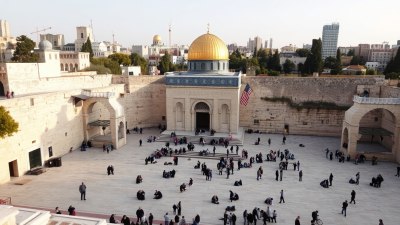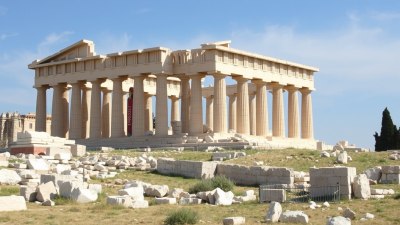The Temple Mount in Jerusalem Hides Its Silence Deep
Explore the profound history and significance of the Temple Mount in Jerusalem, where silence speaks volumes.

Image created with Flux Schnell
The Temple Mount in Jerusalem stands as one of the most significant and controversial religious sites in the world. This ancient location is revered by Jews, Christians, and Muslims alike, each group attributing profound spiritual significance to the site. Its architecture, history, and the layers of cultural narratives that envelop it reveal a complex tapestry of beliefs and traditions. However, beneath its stone surfaces and bustling religious activities, there lies a deep silence that speaks of centuries of conflict, devotion, and mystique.
Historical Background
The Temple Mount, known in Hebrew as Har HaBayit, is a revered site in Jewish tradition, believed to be the location of the First and Second Temples. The First Temple, built by King Solomon around the 10th century BCE, held the Ark of the Covenant and served as the spiritual center of the Jewish people. However, it was destroyed by the Babylonians in 586 BCE. The Second Temple, completed in 516 BCE, stood for nearly six centuries until it was destroyed by the Romans in 70 CE. The Western Wall, a remnant of the Second Temple, remains a place of prayer and pilgrimage for Jews around the world today.
Religious Significance
For Jews, the Temple Mount is the holiest site in Judaism, symbolizing the divine presence and serving as the focal point for prayers and aspirations for a future rebuilt temple. In Christian tradition, it holds importance as the place where Jesus taught and prophesied, making it a site of pilgrimage for many Christians. For Muslims, the Al-Aqsa Mosque and the Dome of the Rock are situated on the Temple Mount, with the latter believed to be the spot from which Prophet Muhammad ascended to heaven during the Night Journey. The complex thus embodies a confluence of religious significance, where silence becomes a powerful testament to faith.
Architectural Elements
The architectural layout of the Temple Mount features remarkable structures that narrate its long history. The Dome of the Rock, with its striking gold dome, was completed in the late 7th century CE and is considered one of the finest examples of early Islamic architecture. It is built over the Foundation Stone, which is symbolic in Judaism as the site of creation and the location where Abraham was to sacrifice his son Isaac. The Al-Aqsa Mosque, established in 709 CE, features stunning Islamic art and a vast prayer hall, creating a spiritual atmosphere that attracts millions of visitors each year.
Modern-Day Significance and Conflict
In contemporary times, the Temple Mount remains a flashpoint for political and religious tensions in Jerusalem. Control of the site is a sensitive issue between Israelis and Palestinians, often igniting violence and protests. Despite these tensions, Muslim authorities maintain administrative control over the site, while Israel retains sovereignty. The delicate balance reflects the broader Israeli-Palestinian conflict, injecting layers of complexity into the spiritual reverence of the Temple Mount. Visitors to the site often experience a unique blend of awe and contemplation, as they observe the rituals, practices, and interactions that unfold.
The Silence of the Temple Mount
Despite its significance and activity, the Temple Mount can also evoke a unique silence. This silence deepens when one considers the historical weight of the site—the struggles, aspirations, and dreams of countless individuals over millennia. The quietude resonates with the hopes for peace, understanding, and reconciliation among the diverse communities that regard the site as sacred. The stillness can also highlight the fragility of coexistence in a place where history often seems to repeat itself in cycles of conflict.
Visitor Experience
Visiting the Temple Mount is an experience filled with stark contrasts. The site allows for moments of reflection amidst the vibrant interaction of faiths. Visitors can observe daily prayers, religious gatherings, and the rituals performed by worshippers from different backgrounds. The complex's atmosphere can shift from lively to somber, reflecting the diversity of beliefs and the ongoing quest for a harmonious existence in Jerusalem.
Tourist Considerations
For tourists wishing to experience the Temple Mount, it is important to understand the cultural and religious sensitivity of the site. Entry is regulated, with visiting hours varying for different faiths. It is advisable to dress modestly and respect the site's sanctity, understanding that the Temple Mount’s significance transcends mere tourism. Observing customs and being respectful towards worshippers enhances the experience and acknowledges the deep-rooted faith present within the grounds.
Spiritual Reflections
The Temple Mount also offers space for spiritual reflection. Many visitors find themselves contemplating faith, history, and the enduring legacy of the site. The silence can inspire deep personal thoughts and conversations among visitors as they engage with the complex narratives at play. Whether it is through prayer, meditation, or simply observing the interactions around them, individuals can explore their personal connections to the site’s sacredness.
Artisans and Local Culture
Nearby, the old city of Jerusalem brims with art and culture that reflect the city's rich diversity. Artisans, shops, and markets contribute to the vibrant atmosphere, allowing visitors to experience local crafts, textiles, and culinary delights. Interactions with local vendors can provide insight into traditional practices and daily life, connecting visitors to the broader cultural heritage of Jerusalem.
The Role of Education
Understanding the complexities surrounding the Temple Mount is crucial for fostering dialogue and education among different communities. Educational initiatives aimed at promoting coexistence, tolerance, and mutual respect can help bridge divides. Programs that explore the shared history and diverse narratives can enhance awareness and foster a deeper sense of compassion for the experiences of others.
Contributions to Global Dialogue
The Temple Mount not only serves as a focal point of local significance but also contributes to global discussions on interfaith dialogue, cultural heritage, and human rights. As a symbol of the interplay between faith and politics, the site inspires conversations about faith in the modern world and the need for peaceful coexistence in diverse societies. Exploring the Temple Mount becomes an act of global awareness, as it reflects the universal longing for understanding and harmony.
The Future of the Temple Mount
As we look toward the future, the Temple Mount’s role remains central in discussions of peace and reconciliation. Advocates for dialogue emphasize the importance of recognizing the site’s shared significance and working towards solutions that honor its multireligious heritage. The silence within the Temple Mount could become a beacon of hope—a reminder of the power of faith to inspire unity rather than division.
In summary, the Temple Mount in Jerusalem encapsulates centuries of religious devotion, historical strife, and the quest for spiritual sanctuary. Its silence is plentiful and profound, echoing through the ages and inviting contemplation for future generations. As visitors traverse its grounds, they not only encounter a geographical landmark but also the embodiment of a shared legacy that continues to shape discussions around faith, identity, and coexistence.











